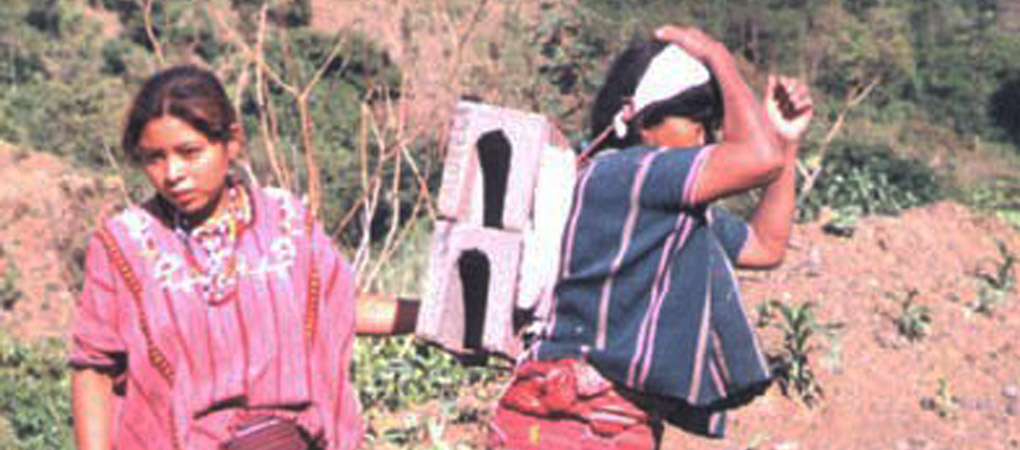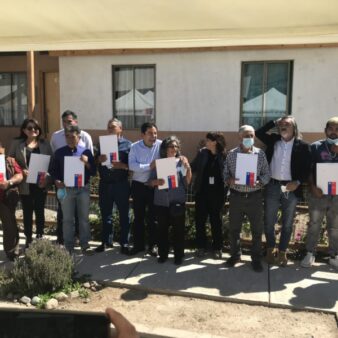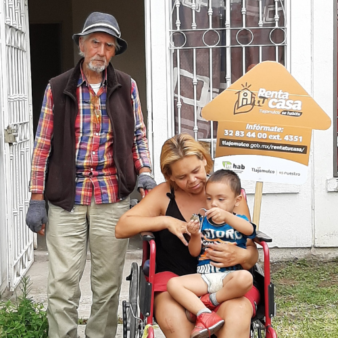This nationwide housing programme arose out of the 1996 Peace Accords established in Guatemala at the end of a long civil war. As well as providing decent homes for 18,000 people to date, the project also works to restore the communities that have been damaged by the hostilities of the civil war. Local people are involved at all stages of the project, including the construction of the dwellings.
Project Description
Aims and Objectives
- To improve the housing conditions of the poor in a way which involves the people themselves and fosters local and regional development.
- To put into practice the elements of the Peace Accords in order to improve the quality of life of poor households through the provision of decent homes.
- To promote the organisation and development of local communities and to break down some of the hostilities that emerged during the civil war years.
- To ensure that housing is seen in its broader context relating to health, environment, provision of a finance asset, security and well-being.
Guatemala is located in Central America and two-thirds of its terrain is mountainous. It has a population of 12 million, 39 per cent of whom live in urban areas. At 26 births per 1000 it has the highest birth rate in Latin America. Average life expectancy is 60 years and with a GNP per capita of $1,660 Guatemala ranks 110 out of 206 countries in the world. 40 per cent of the population live on less than $1 a day.
There is a shortage of 1,640,000 dwelling units, 900,000 for households without their own home and 740,000 that needed to be rebuilt because there are of such poor quality (UNDP 2000). Investment in housing is low and erratic. The country has been subject to political turmoil with 36-year-long civil war coming to an end with the peace agreement of 1996. Over 200,000 people were killed or disappeared during these years and the nation’s social cohesion was severely damaged. The country is also prone to physical devastation from earthquake and hurricane (e.g. Hurricane Mitch in 1998 bought widespread devastation).
The aim of the Habitat Solution for Peace and Development project is to meet the housing needs of the people who are living in poverty. These include those returning from exile and the internally displaced resulting from the years of civil war as well as the rural poor indigenous population, primarily the indigenous Mayan population.
To date the programme has developed projects in 50 communities in 11 of the country’s 22 departments. A total of 3,006 family dwellings have been built with the total number of beneficiaries being over 18,000 persons. These dwellings are primarily located in rural areas and occupied by people who are poor. Under its Housing Solutions for Peace and Development progarmme, FGT intends to continue providing 600 dwellings a year for the next five years.
The key features of the project are the involvement of local communities in the building of their own housing. The community organises itself to carry out the project in co-operation with FGT. Before and during the development of the housing project, FGT provides a series of housing workshops – for women in order to strengthen women’s participation, on community regeneration, on decision-making and on the local environment (seeking to identify the problems and resources of the local environment). Practical construction techniques are also taught with courses covering land preparation, surveying, foundations, bricklaying, roofing and flooring.
The houses are 50m2 in size with four rooms (living /kitchen, hallway, two bedrooms). They are typically made of blocks and solid columns and roofs are made of metal sheets. Where possible locally available materials, such as adobe or stone, are used to build the walls. The basic principles of design have been learned from previous projects and modified over time so that the designs discussed with local communities represent an amalgam of good practice. Several different designs/models are offered to the community, who select one and adapt it to their circumstances. Also, the housing is designed to be capable of extension at a later date.
Great emphasis has been placed on improving consultation and co-operation between people as part of the building process. The increased capacity of people to negotiate with the local municipalities has led to a marked increase in the efficiency and effectiveness of the government’s housing administration. In most cases the committees established in the project continue to function when the houses have been completed. These committees can negotiate with the local municipality on behalf of the community for services such as roads and utilities and also for health and education provision.
The capital cost of construction of a house is $2,710 of which 25 per cent is the community’s contribution (labour and materials) and the government subsidy is 75 per cent. It is a requirement of the government subsidy that the beneficiary should meet one quarter of the total cost. The revenue costs are met by the residents themselves. A guarantee is given to the owner of the property to cover any faults in materials or construction for 18 months.
Why is it innovative?
- Abandonment of the formerly used ‘minimum investment’ concept of housing provision and acceptance of the concept of ‘dignified housing’ as a human right.
- Recognition of the importance for the poor of having a capital asset.
- Guaranteeing community participation in the design and implementation of housing projects.
- Good governance of the organisation in the use of government funds.
- Use of housing designs adapted to the needs of the local community.
- Promotion of partnership working between institutions to foster integral policies and programmes.
- Learning from experiences in other projects to encourage the use of high quality housing solutions.
What is the environmental impact?
Wherever possible locally sourced materials, such as stone or earth, are used to construct the houses. Wood is only used if it does not deplete the environment. There is, however, an increased consumption of water and electricity as these services are provided to communities where previously there had not been any.
Is it financially sustainable?
FGT was set up to ensure that the government funds allocated for post conflict housing is spent to build communities as well as houses. The project provides training in construction skills as well as political awareness / negotiating skills to increase the capacity of communities to apply for further funds to develop infrastructure and services from their local municipality.
What is the social impact?
The holistic approach of the project encourages community participation and social integration. The combined factors of community involvement, co-operation between people and financial stability further ensures the continuity of the project – in a manner that are suited to the local conditions.
Transfer
30 individual projects have been completed in 11 of Guatemala’s 22 national departments.
The project was selected as the winner of the National Prize for Social Management 2005. This prize is given by the Interamerican Development Bank together with the Interamerican Institute for Social Development and the National Institute for Public Administration.
Partnership
NGO, national government, local government, local community



